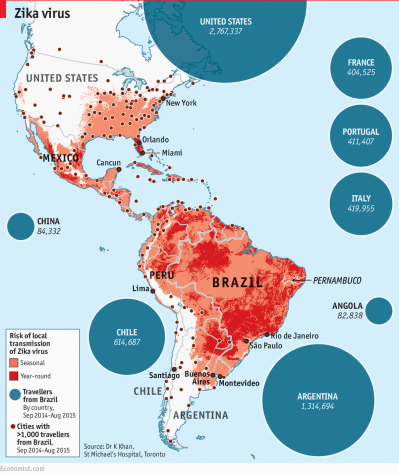Social Issue: Zika Virus
March 22, 2016
The Regina Dominican graphic design classes have been working on social justice issue posters during class. Each visual explains a specific social justice issue and presents the message through art and minimal text.
Larkin McGarr’s ’16 project took on the spread of the Zika virus in South America and the impact it may have for the upcoming summer Olympics to be held in Brazil.
The Zika virus is an insect vector-borne disease most commonly transmitted through mosquitoes. It is an epidemic in parts of Africa, Asia, and South America.
The number of cases and the location of the outbreak qualify it as a rapidly growing epidemic threat. The disease has been transmitted through humans and mosquitoes. According to CNN, the virus has been spread to at least 34 countries and territories.

The Zika virus was first discovered in 1947 and it is named after the Zika Forest in Uganda. The first Zika outbreak was reported in 1952, and since then, outbreaks have been reported in tropical areas across the world. At least 14 outbreaks were reported in 2007. Currently, outbreaks continue to occur, according to Centers for Disease Control and Prevention (CDC).
The evidence suggests the spread of mosquitoes and the Zika Virus during the current summer season in the southern hemisphere is due to environmental factors such as climate change and the influence of the El Niño effect.
Some symptoms of the virus include fever, rash, joint pain, and red eyes. The diagnosis can be confirmed by blood tests. There is no vaccine for the disease, but those infected must stay hydrated and get plenty of sleep.
The Zika virus infection in pregnant women has been linked to serious birth defects and miscarriages. The Zika virus is diagnosed by symptoms and whether or not there is an outbreak near one’s community. In the United States, the CDC predicts that 80% of cases will not be diagnosed.
According to Direct Relief: Humanitarian Medical Aid, the Zika virus is associated with Guillain-Barre syndrome. Guillain-Barre syndrome is when a person’s immune system attacks itself, particularly affecting the nervous system cells. An individual can get this disease by infection with various bacteria or viruses. The symptoms include muscular weakness and tingling in the arms and legs, according to Pan American Health Organization.
Prevention for the Zika virus may include the reduction of mosquito populations and avoiding mosquito bites. To avoid bites, people should avoid standing in water, avoid accumulating garbage, wear long sleeves and pants, and use screens and mosquito nets on windows, doors,and over beds.
The U.S. Olympic Committee (USOC) told U.S. sports federations that they are concerned for the athletes’ health because of the virus and they have recommended that athletes should think about going to the Olympics, according to a Reuters article.
Regina Dominican nurse Martha Barthel says, “The Olympic association is saying that it is going to be controlled and monitored, but there is no way to fully prevent being associated with the virus.”
Precautions will be up to individuals travelling to the Olympics, and they should follow CDC recommendations. U.S. soccer goalie Hope Solo stated that if the games were about to begin today, she would opt out of Rio.
“Team USA looks forward to the Games and we did not, would not, and will not prevent athletes from competing for their country should they qualify,” USOC spokesman Patrick Sandusky said. The USOC will supply mosquito netting and insect repellent and will stress not standing in water. Organizers are inspecting Olympic venues and facilities and will do inspections on a daily basis during the games.
Senior, Larkin McGarr, created a visual explaining the Zika Virus and its possible impact on the 2016 Rio Olympic Games. She answered the following questions regarding her project:
Q: Why is this topic important to you?
A: “This is important to me because I think not too many people know about the Zika virus and how it can not only effect the host, but its future generations as well.”
Q: What are you trying to accomplish with this visual?
A: “The rings are made of the Zika virus structure and they are supposed to look like the Olympic Rings. It’s very risky going to the Olympic Games in Rio because the drinking water/swimming water is infested with the Zika virus.”
Q: What was your inspiration?
A: “My inspiration was the Zika virus. Because of its bright colors, I wanted to make the background plain, so that would stand out.”
Q: Explain your visual.
A: “The rings are the structure of the Zika virus and they’re made to look like the Olympic Rings. The ‘O’ in Rio is the Zika virus itself. And the quote at the bottom means that truly anyone can contact this disease.”


